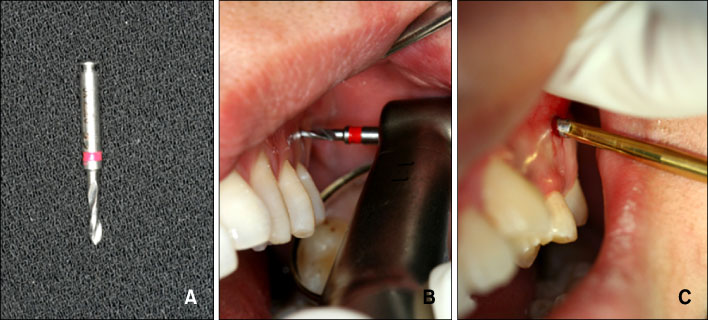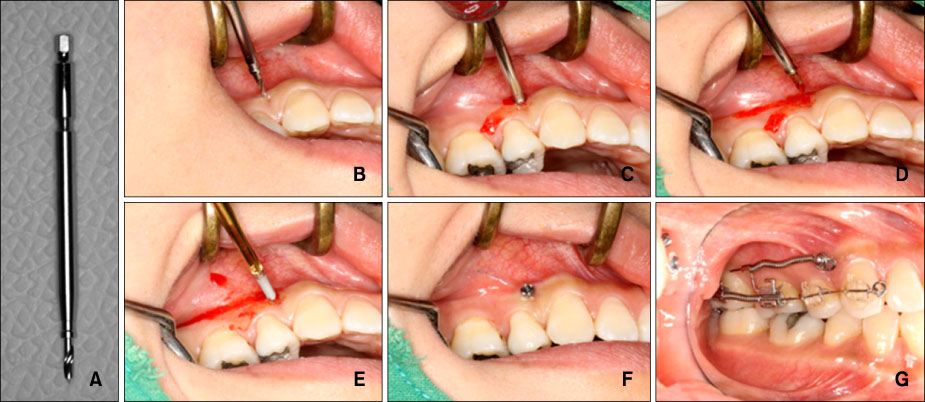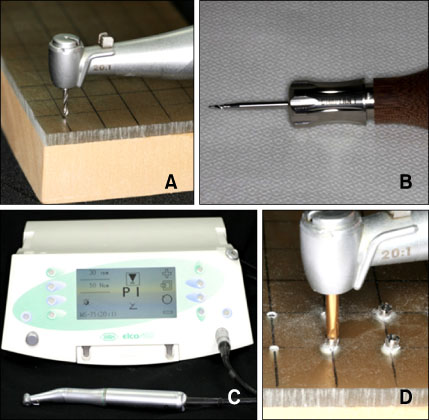Korean J Orthod.
2011 Oct;41(5):354-360. 10.4041/kjod.2011.41.5.354.
The effects of different pilot-drilling methods on the mechanical stability of a mini-implant system at placement and removal: a preliminary study
- Affiliations
-
- 1Department of Orthodontics, School of Dentistry, Seoul National University, Korea.
- 2Department of Craniofacial Orthodontics, Childrens' Hospital of Phildelphia, USA.
- 3Department of Prosthodontics, School of Dentistry, Seoul National University, Korea.
- 4Department of Restorative Dentistry, School of Dentistry, Kyung Hee University, Korea.
- 5Department of Dentistry, School of Medicine, Ajou University, Korea.
- 6Department of Orthodontics, School of Dentistry, Kyung Hee University, Korea. bravortho@hanmail.net
- 7Division of Orthodontics, Department of Orofacial Science, University of California SanFrancisco, USA.
- KMID: 1975392
- DOI: http://doi.org/10.4041/kjod.2011.41.5.354
Abstract
OBJECTIVE
To investigate the effects of different pilot-drilling methods on the biomechanical stability of self-tapping mini-implant systems at the time of placement in and removal from artificial bone blocks.
METHODS
Two types of artificial bone blocks (2-mm and 4-mm, 102-pounds per cubic foot [102-PCF] polyurethane foam layered over 100-mm, 40-PCF polyurethane foam) were custom-fabricated. Eight mini-implants were placed using the conventional motor-driven pilot-drilling method and another 8 mini-implants were placed using a novel manual pilot-drilling method (using a manual drill) within each of the 2-mm and 4-mm layered blocks. The maximum torque values at insertion and removal of the mini-implants were measured, and the total energy was calculated. The data were statistically analyzed using linear regression analysis.
RESULTS
The maximum insertion torque was similar regardless of block thickness or pilot-drilling method. Regardless of the pilot-drilling method, the maximum removal torque for the 4-mm block was statistically higher than that for the 2-mm block. For a given block, the total energy at both insertion and removal of the mini-implant for the manual pilot-drilling method were statistically higher than those for the motor-driven pilot-drilling method. Further, the total energies at removal for the 2-mm block was higher than that for the 4-mm block, but the energies at insertion were not influenced by the type of bone blocks.
CONCLUSIONS
During the insertion and removal of mini-implants in artificial bone blocks, the effect of the manual pilot-drilling method on energy usage was similar to that of the conventional, motor-driven pilot-drilling method.
Figure
Reference
-
1. Lee SY, Cha JY, Yoon TM, Park YC. The effect of loading time on the stability of mini-implant. Korean J Orthod. 2008. 38:149–158.
Article2. Cha JY, Yoon TM, Hwang CJ. Insertion and removal torques according to orthodontic mini-screw design. Korean J Orthod. 2008. 38:5–12.
Article3. Yun S, Lim S. Effect of cutting flute length and shape on insertion and removal torque of orthodontic mini-implants. Korean J Orthod. 2009. 39:95–104.
Article4. Su YY, Wilmes B, Hönscheid R, Drescher D. Comparison of self-tapping and self-drilling orthodontic mini-implants: an animal study of insertion torque and displacement under lateral loading. Int J Oral Maxillofac Implants. 2009. 24:404–411.5. Baumgaertel S. Predrilling of the implant site: is it necessary for orthodontic mini-implants? Am J Orthod Dentofacial Orthop. 2010. 137:825–829.
Article6. Jeon MS, Kang YG, Mo SS, Lee KH, Kook YA, Kim SH. Effects of surface treatment on the osseointegration potential of orthodontic mini-implant. Korean J Orthod. 2008. 38:328–336.
Article7. Kim SH, Cho JH, Chung KR, Kook YA, Nelson G. Removal torque values of surface-treated mini-implants after loading. Am J Orthod Dentofacial Orthop. 2008. 134:36–43.
Article8. Lee SJ, Ahn SJ, Lee JW, Kim SH, Kim TW. Survival analysis of orthodontic mini-implants. Am J Orthod Dentofacial Orthop. 2010. 137:194–199.
Article9. Park SH, Kim SH, Ryu JH, Kang YG, Chung KR, Kook YA. Bone-implant contact and mobility of surface-treated orthodontic micro-implants in dogs. Korean J Orthod. 2008. 38:416–426.
Article10. Mo SS, Kim SH, Kook YA, Jeong DM, Chung KR, Nelson G. Resistance to immediate orthodontic loading of surface-treated mini-implants. Angle Orthod. 2010. 80:123–129.
Article11. Kim SH, Lee SJ, Cho IS, Kim SK, Kim TW. Rotational resistance of surface-treated mini-implants. Angle Orthod. 2009. 79:899–907.
Article12. Cleveland JL, Kohn W. CDC weighs in on TADs. Am J Orthod Dentofacial Orthop. 2009. 136:622–623.
Article13. Park KJ. Relationship between implant stability quotient (ISQ) values and implant insertion variables: a clinical study (thesis). 2007. Seoul: Seoul National University.14. Kim SH, Kang SM, Choi YS, Kook YA, Chung KR, Huang JC. Cone-beam computed tomography evaluation of mini-implants after placement: is root proximity a major risk factor for failure? Am J Orthod Dentofacial Orthop. 2010. 138:264–276.
Article15. Serra G, Morais LS, Elias CN, Meyers MA, Andrade L, Müller CA, et al. Sequential bone healing of immediately loaded mini-implants: histomorphometric and fluorescence analysis. Am J Orthod Dentofacial Orthop. 2010. 137:80–90.
Article16. Cha JY, Takano-Yamamoto T, Hwang CJ. The effect of miniscrew taper morphology on insertion and removal torque in dogs. Int J Oral Maxillofac Implants. 2010. 25:777–783.17. Lim SA, Cha JY, Hwang CJ. Insertion torque of orthodontic miniscrews according to changes in shape, diameter and length. Angle Orthod. 2008. 78:234–240.
Article18. Brinley CL, Behrents R, Kim KB, Condoor S, Kyung HM, Buschang PH. Pitch and longitudinal fluting effects on the primary stability of miniscrew implants. Angle Orthod. 2009. 79:1156–1161.
Article19. Chen Y, Kyung HM, Gao L, Yu WJ, Bae EJ, Kim SM. Mechanical properties of self-drilling orthodontic micro-implants with different diameters. Angle Orthod. 2010. 80:821–827.
Article20. Kim JW, Ahn SJ, Chang YI. Histomorphometric and mechanical analyses of the drill-free screw as orthodontic anchorage. Am J Orthod Dentofacial Orthop. 2005. 128:190–194.
Article
- Full Text Links
- Actions
-
Cited
- CITED
-
- Close
- Share
- Similar articles
-
- Effect of dual pitch mini-implant design and diameter of an orthodontic mini-implant on the insertion and removal torque
- Histologic and biomechanical characteristics of orthodontic self-drilling and self-tapping microscrew implants
- Influence of late removal after treatment on the removal torque of microimplants
- Mechanical analysis of the taper shape and length of orthodontic mini-implant for initial stability
- The effect of osteotome technique on primary implant stability according to implant fixture diameter






